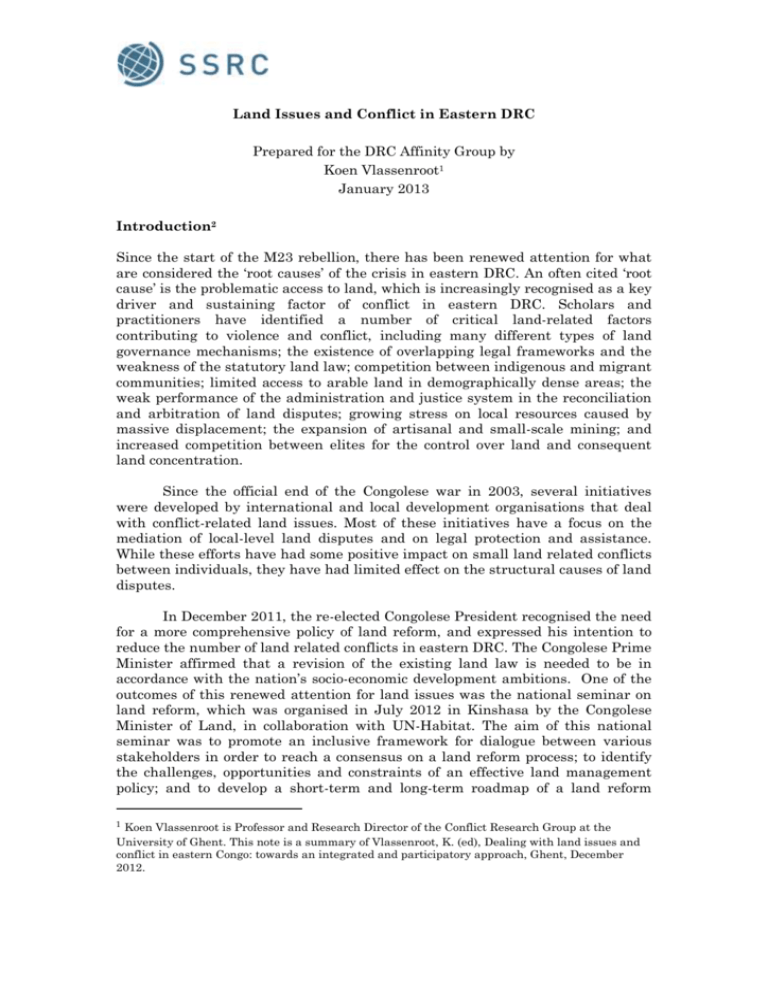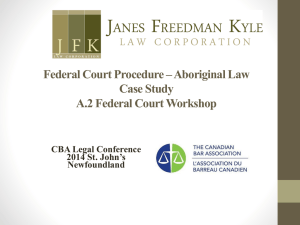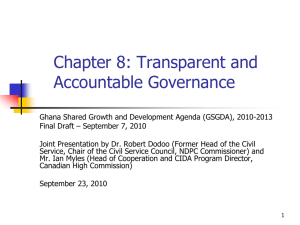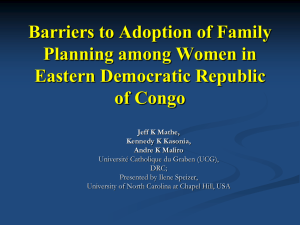Land Issues and Conflict in Eastern DRC Prepared for the DRC
advertisement

Land Issues and Conflict in Eastern DRC Prepared for the DRC Affinity Group by Koen Vlassenroot1 January 2013 Introduction2 Since the start of the M23 rebellion, there has been renewed attention for what are considered the ‘root causes’ of the crisis in eastern DRC. An often cited ‘root cause’ is the problematic access to land, which is increasingly recognised as a key driver and sustaining factor of conflict in eastern DRC. Scholars and practitioners have identified a number of critical land-related factors contributing to violence and conflict, including many different types of land governance mechanisms; the existence of overlapping legal frameworks and the weakness of the statutory land law; competition between indigenous and migrant communities; limited access to arable land in demographically dense areas; the weak performance of the administration and justice system in the reconciliation and arbitration of land disputes; growing stress on local resources caused by massive displacement; the expansion of artisanal and small-scale mining; and increased competition between elites for the control over land and consequent land concentration. Since the official end of the Congolese war in 2003, several initiatives were developed by international and local development organisations that deal with conflict-related land issues. Most of these initiatives have a focus on the mediation of local-level land disputes and on legal protection and assistance. While these efforts have had some positive impact on small land related conflicts between individuals, they have had limited effect on the structural causes of land disputes. In December 2011, the re-elected Congolese President recognised the need for a more comprehensive policy of land reform, and expressed his intention to reduce the number of land related conflicts in eastern DRC. The Congolese Prime Minister affirmed that a revision of the existing land law is needed to be in accordance with the nation’s socio-economic development ambitions. One of the outcomes of this renewed attention for land issues was the national seminar on land reform, which was organised in July 2012 in Kinshasa by the Congolese Minister of Land, in collaboration with UN-Habitat. The aim of this national seminar was to promote an inclusive framework for dialogue between various stakeholders in order to reach a consensus on a land reform process; to identify the challenges, opportunities and constraints of an effective land management policy; and to develop a short-term and long-term roadmap of a land reform Koen Vlassenroot is Professor and Research Director of the Conflict Research Group at the University of Ghent. This note is a summary of Vlassenroot, K. (ed), Dealing with land issues and conflict in eastern Congo: towards an integrated and participatory approach, Ghent, December 2012. 1 process. During this seminar, it was agreed that a new land policy, including a revision of the General Property Law of 1973 was required, and a detailed roadmap for a participatory land reform process was adopted. Since this national seminar, several discussions and workshops have been organised in Goma, Brussels, Bukavu and Kinshasa by various stakeholders, but so far limited progress has been made in the implementation of this comprehensive land reform process. This note highlights some of the key links between land governance and conflict in eastern DRC, provides an assessment of current initiatives, and presents a number of policy options. Land issues as trigger of conflict In eastern DRC, land issues are closely connected to dynamics of violence and conflict. The poor governance of land allocation and transfers has been a source of structural violence in the entire country, but it is mainly in the Kivu provinces and Ituri where it has led to massive violence. A context of multiple and often contradictory land rights, a weak governance framework and a failing justice system have had a considerable impact on the socio-economic and legal position of rural populations and have led to growing confusion over land rights and access. In most cases, the consequent disputes and disagreements have remained limited to the individual level. But in certain areas, land issues have been a major source of conflict between different communities. The Congolese wars have only reinforced the importance of land issues in local conflict, with references to land being a key ingredient of mobilisation efforts by armed groups. But land has also turned into a resource of war and of speculation, to the advantage of politicomilitary elites. The effects of these dynamics, however, tend to vary from place to place depending on the local history, the composition and density of the population, the local governance context and administrative organisation, and the implication of politico-military elites: Most studies define ‘the land problem’ as a result of contradictions in the existing legal framework and the lack of a transparent land governance framework. As in many other contexts, access to and use of land are governed in the DRC through a multitude of systems, practices and institutional structures (just for variety), including a statutory land system, customary systems and a variety of informal land governance practices. These systems lack harmonization, have different legal statuses and are based on different rules, rights and obligations. The effects of these contradictions are further worsened by the lack of a true land policy. Land tenure policies are based on often conflicting documents and statements, which explains why there are no clear standards for the registration of land. This, in turn, leads to confusion, tension, competing claims of ownership or user rights, and, ultimately, various forms and degrees of violent conflict. A complicating factor is the lack of clarity about the exact duties and competencies of customary chiefs. Given their double status as representatives of the traditional order and heads of the local administration units, customary chiefs have always played a prominent role in the distribution of land. However, the local authority and legitimacy of these customary chiefs has been seriously 2 affected by their involvement in the selling of communal land (often without informing the communities they are supposed to represent), their dubious position during the war (some have supported rebel groups while others have left their territories) and their involvement in local networks of patronage. The Congo wars have had a devastating impact on the already very fragile land governance context, which further exemplifies the negative effects of the existing legal framework. A first impact is the lack of any reliable land regulating or legal protection mechanisms for small farmers. The justice system today has a very marginal role in resolving land disputes because it is extremely fragile and affected by corruption, and thus considered an unreliable arbiter by parties in conflict. Customary justice mechanisms have also lost much of their credibility and capacity for similar reasons. During the war, land access patterns in conflict-affected areas have radically changed, partly as a result of forced displacement, but also because of the loss of authority of customary chiefs and administrations to the advantage of a new class of politico-military strongmen. Land turned into a new source of speculation and of rent-seeking activities, which was facilitated by the institutional vacuum created by the collapse of the Congolese state. In the Kivus, politico-military leaders came to be deeply involved in land-grabbing strategies, either to redistribute land to their supporters or to confiscate ranching land for their own benefit. In order to consolidate their control over land transactions, rebel groups also tried to further reduce the power of customary chiefs, or created new administrative entities and boundaries and instituted parallel power structures. Another complicating factor is the return of refugees to their areas of origin. Particularly the recent return of Tutsi refugees from Rwanda to Masisi and Kalehe has instigated new land claims and has intensified tensions between local communities. In these areas, lack of legal protection, weakness of the local administration and lack of available arable land causes renewed competition and tension, and has affected ethnic cohabitation and security conditions. In North Kivu, there have been several moves by high-ranking military officers to organize and encourage the return of refugees or to facilitate the migration of large groups of people to other areas, in some cases with the complicity of customary chiefs. This has gone hand in hand with a forced redistribution of land to the advantage of refugee-returnees, which has caused renewed tension between different communities and mobilisation by armed groups. Experiences in resolving land tensions Donors and local organisations have increasingly recognized land issues as a key priority, and many organisations have piloted activities dealing with land-related conflicts. Donors have also acknowledged the importance of land conflicts in DRC and the need to develop adapted strategies. This has led to a great variety of perspectives, approaches and strategies, including small-scale activities founded purely on voluntary effort as well as sustained and comprehensive large-scale interventions. Three different approaches can be distinguished. The most important group of interventions includes initiatives at a local level that respond to specific 3 disputes and focus mostly on community-level mediation and reconciliation, which by far is the most common form of intervention. Some of the existing mediation initiatives were implemented to respond to specific events, such as the return of refugees or displaced people and their claims on land. Most of these mediation committees specialise in land conflict mediation, but also tackle a variety of disputes, with land issues being the most common kind (typically 6070% of all disputes). While many organisations support community-level mediation of land disputes, the majority of disputes treated are those types, which are not likely to result in large-scale violence. A second group of interventions focus directly on land governance. Several NGOs have attempted to help communities register land or have tried to provide legal ‘accompaniment’ for those smallholders seeking title deeds to their land. Attempts have also been made to link customary and state systems and to develop local land registers, which would ‘formalize’ transactions approved by customary chiefs. A final group of initiatives focus on policy at the legislative levels and include the vulgarisation of the land law and related legal frameworks, but also consist of advocacy efforts by Congolese civil society to change this framework. Each of these initiatives has had some positive impact on local conditions of land governance. Even if in most cases their impact is limited in scope and time, local initiatives provide an essential alternative and respond to a direct need in areas where land governance is weak and justice mechanisms are either corrupt or non-existent. One of the strengths of local level initiatives is their inclusiveness and their participatory approach, which gives them a significant level of local legitimacy. The effects of these initiatives can even go beyond land governance issues as their inclusiveness also provides some opportunities to larger-scale reconciliation and peace-building. Existing approaches have limited effect though on the underlying causes of land disputes, which in most cases are left unaddressed either because they are considered to be too complex or because of the lack of impact on powerful actors involved in these conflicts. Furthermore, when land-related disputes are affecting larger-scale ethnic cohabitation, current initiatives tend to have limited impact. There is also a lack of coordination between the multitude of initiatives targeting this issue. Each initiative starts from its own objectives, logics, methodology and strategies, leading to duplication and increased competition. The role of donor agencies is also often extremely crucial, which causes concerns about the sustainability of these initiatives once donors are no longer involved. Policy options A transparent and responsible land governance framework is an essential ingredient of a comprehensive strategy of conflict resolution and peace building in eastern DRC. This strategy needs to address the causes of land conflicts but also to facilitate a land reform process but should not stand on its own. Developing such strategy without tackling the larger governance crisis and without improving the functioning of the justice apparatus will have limited effect. Also, this reform strategy is a long-term political process that cannot be reduced to a technical intervention. The roadmap that was adopted in Kinshasa 4 in July 2012 could serve as a starting point, but its success depends on the right follow-up decisions, strategies and initiatives as well as immense political will from many key actors. It creates a window for change but without real political commitment, risks being a long-term process with a very uncertain outcome. Other land reform examples in similar contexts have revealed that such processes usually take much longer than expected, tend to be too centrally controlled (with national land commissions as obstacles to, instead of instruments of reform) and not always tackling the key issues. The real challenge thus is to assure that policy reform has a real output and impact. This requires the entrenchment of a land policy in a well-designed and effective legal framework, but also a transformation of land policy and the strengthening of the larger governance framework and justice apparatus. To have a longer-term impact in eastern DRC, there is of course a minimum of stability and security needed. It should also be recognised that in addition of a national framework, local realities need to be taken into account and specific strategies need to be developed because what is good for one part of the country is not necessarily a priority for other parts. And this process will also challenge people’s positions, claims and power. Land is a key issue framing the conflict in eastern DRC and tackling this will open a Pandora’s Box, exposing a plethora of other issues. But it is a critical condition to create some form of stability and thus must be part of any comprehensive approach to the current crisis. During a seminar held in Brussels in September 2012, participants concluded that a comprehensive strategy should be based on two main principles: (i) a collaboration with and reinforcement of the state, which is a critical condition to a successful policy—state actors need to be accompanied and supported in their role, and collaboration between state and non-state actors has be reinforced; (ii) an integrated and participatory approach, which is based on ‘learning by doing from the bottom-up’ rather than developing a top-down reform process—such an approach could be based on a number of carefully selected pilot projects in various territorial units and involve all relevant stake-holders. Such a participatory approach will be time-consuming and will only have effects on the mid- or long-term. On the short term, existing mediation and reconciliation efforts should be supported but also be revised and strengthened to also have an impact on larger land disputes and to tackle the ‘collective’ and inter-communal aspects of land disputes. These efforts also will be more effective if these are credible, rooted (at least partially) in local understandings of land tenure systems as well as state law, and supported by local and higher-level authorities. 5








